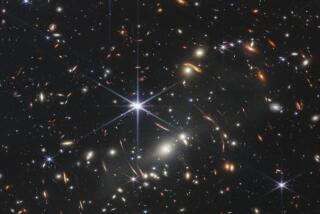BOOK REVIEW : Scientific Quest for What We Cannot ‘See’ : THROUGH A UNIVERSE DARKLY: A Cosmic Tale of Ancient Ethers, Dark Matter and the Fate of the Universe <i> by Marcia Bartusiak</i> ; HarperCollins $27.50, 383 pages
- Share via
Maybe history is cyclical. At the close of the 19th Century, several highly respected physicists declared that physics had completed its work with the formulation of the Theory of Electromagnetics. Within a decade, however, electrons, X-rays and the Theory of Relativity showed how much more work remained to be done. Now, as the 20th Century draws to a close, physicist Stephen Hawking has once again pronounced the end of physics.
This time there is more open opposition. Like most of the myriad of astrophysicists Marcia Bartusiak introduces us to in “Through a Universe Darkly,” Bernard Sadoulet, at the Center for Particle Astrophysics at UC Berkeley, “couldn’t disagree more.”
Bartusiak, a prize-winning science writer with a graduate degree in physics, describes with clarity, color and enthusiasm the search for the mysterious substance that seems to permeate vast areas in space. We cannot “see” it, not with any existing instruments, but it is the “something” that exerts the gravitational pull that keeps galaxies from flying apart.
In their quest for this “something,” astrophysicists disagree about what they will find. Whatever it is, they believe they are on the brink of a discovery that is so big they can barely contain their excitement.
Bartusiak begins, as she must, with the ancient Greeks, who pondered the composition of matter, posited atoms as the smallest possible particles, separated the earth from the heavens and filled the heavens with a mysterious substance they called “the ether.”
By the end of the 19th Century, modern physics and chemistry had begun to identify atoms of different elements, all of which would soon take their places in the familiar Periodic Table.
The ether, though re-conceptualized from ancient days and still undetected, was considered a necessary substance to transmit light. Bartusiak explains, “It seemed like common sense: Sound waves move through air, and ocean waves travel through water; if there is a wave, something must be waving.”
Bartusiak explains that the ether served the 19th Century physicist James Maxwell like a sculptor’s mold: It was required at first for him to cast his theory but was expendable as soon as the theory was formed. After Maxwell had discovered that “light was simply a propagating wave of electric and magnetic energy,” the ether became irrelevant. Eventually efforts were made to measure it, and when it turned out not to be there, it finally fell from grace.
With the development of spectroscopy and its marriage with photography, astronomers had a new tool for exploring the heavens. The spectroscope revealed that patterns emanating from the stars were the same as those emanating from the elements on Earth. Within a few years it seemed clear that the same elements found on earth were found in space, that the earth and other heavenly bodies were made of the same things.
Bartusiak introduces a large cast of remarkable astronomers and describes their often idiosyncratic work habits and obsessions. She tells us about the women used as human computers at the Harvard observatory at the turn of the century, and of the first woman to get a Harvard Ph.D in astronomy in 1925, Cecilia Payne-Gaposchkin.
Looking into the depths of the sky is also looking back in time, for when light reaches us from a distant object, we are really seeing what happened a long time ago. Astrophysicists investigating the origins of light and other waves, in other words, are searching for evidence of the beginning of the universe--the Big Bang.
New technologies have expanded our vision and revealed dark sections of space. Because something in these dark spaces exerts a pull on matter we can see, we know it must be there. Whether called “missing” or “dark,” it appears to be, like the old ether, unlike matter ordinarily found on Earth. It may be negative matter or subatomic particles that only exist on Earth for fractions of a second in super-fast accelerators.
This was all theory until 1992 when NASA’s COBE satellite detected slight differences in temperature in the background radiation in space, evidence of the Big Bang. Now the search has heated up.
One of the most provocative interviews Bartusiak conducts is with Sadoulet at Berkeley. He speculates that “if dark matter is made up of particles that are not ordinary matter,” it would mean that the very atoms that make us up are only a minor constituent of the universe, and the rest is completely different. Depending on how the human ego works, that makes us either insignificant in the grand scheme of things or very special indeed.






